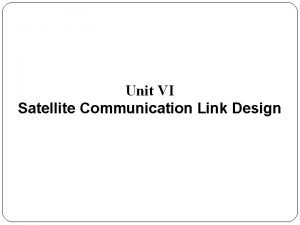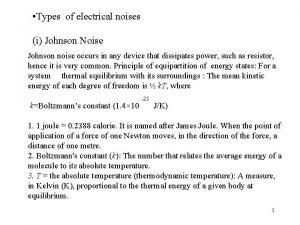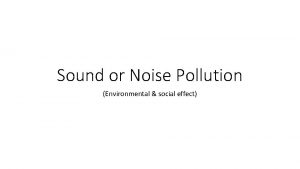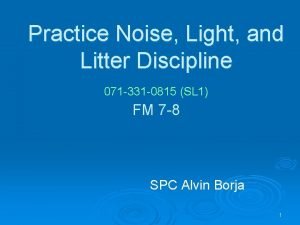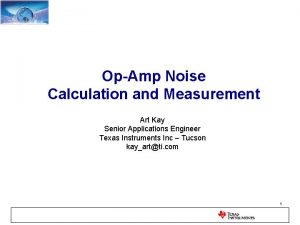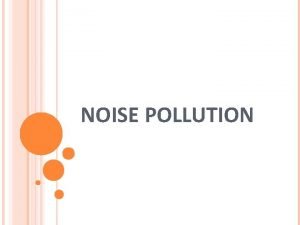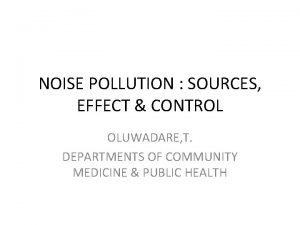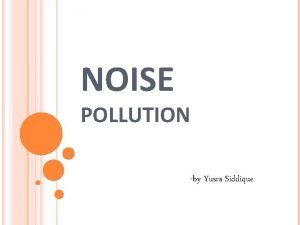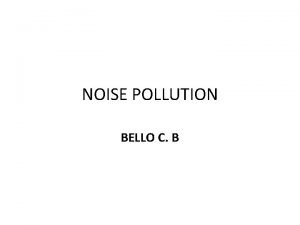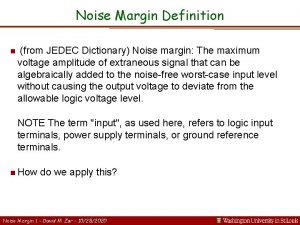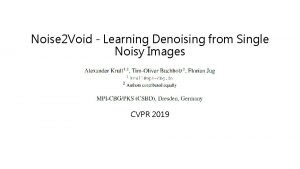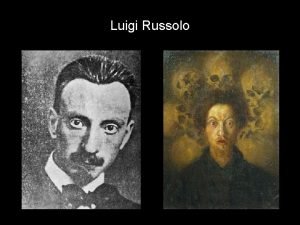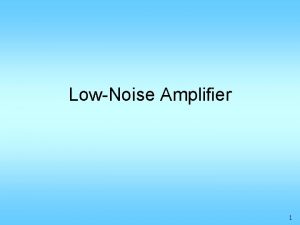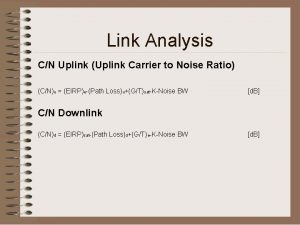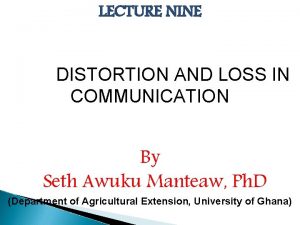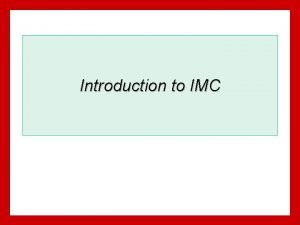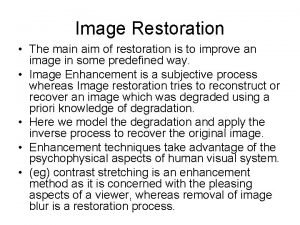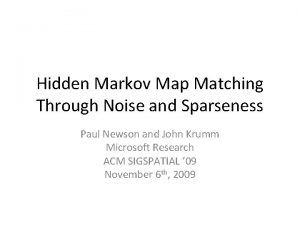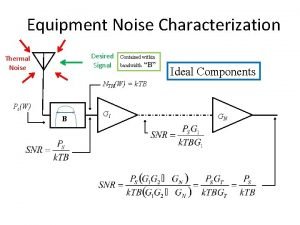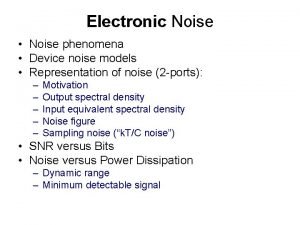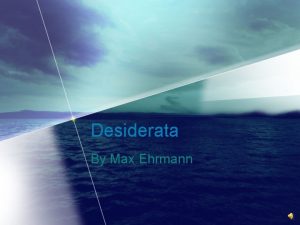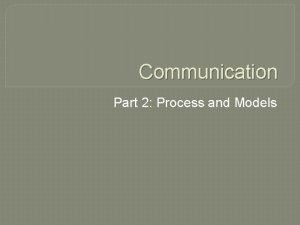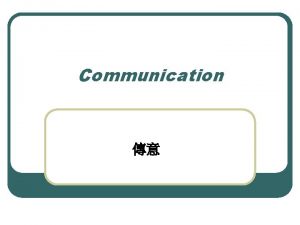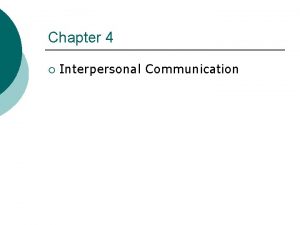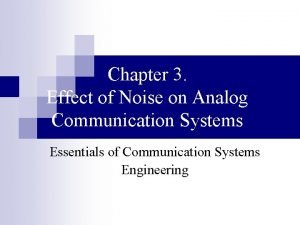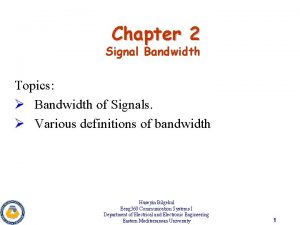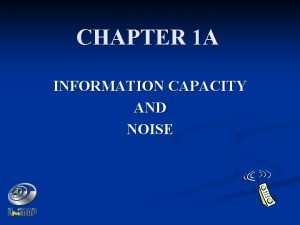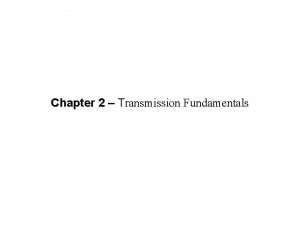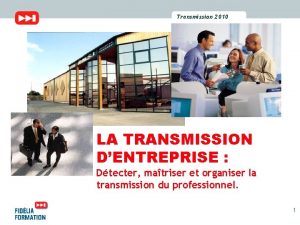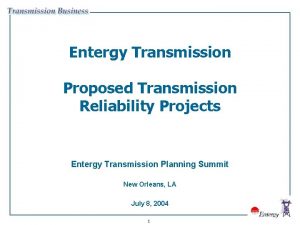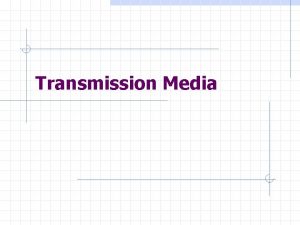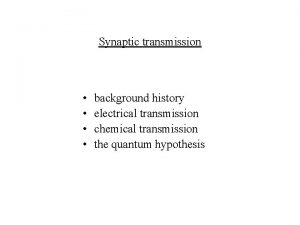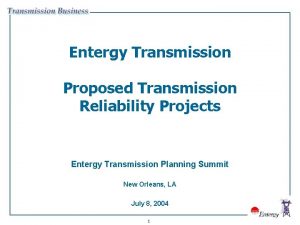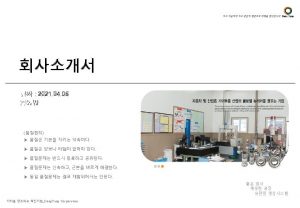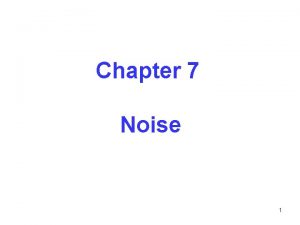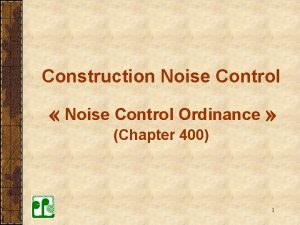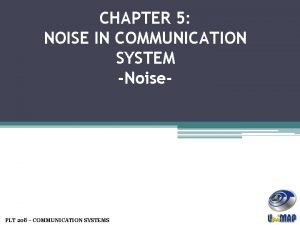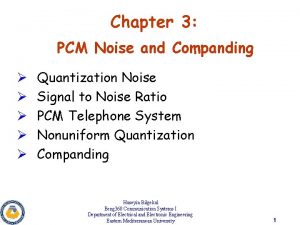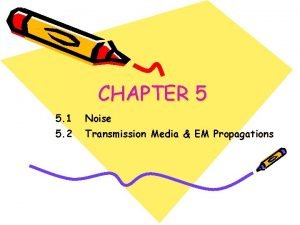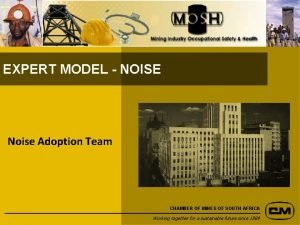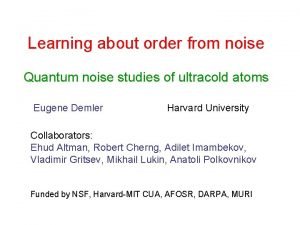CHAPTER 5 5 1 5 2 Noise Transmission













































- Slides: 45

CHAPTER 5 5. 1 5. 2 Noise Transmission Media & EM Propagations

Introduction Define as • undesired random variations that interface with the desired signal and inhibit communication. Where does noise originate in a communication system? • Channel @ transmission medium • Devices @ Equipments

Cont’d. . . Noise Effect • One of the main limiting factor in obtaining high performance of a communication system. • Decrease the quality of the receiving signal.

Block Diagram of Communication System With the Existence of Noise

Cont’d. . . • Noise, interference and distortion – Noise • Refers to random and unpredictable electrical signals produced by natural process. • Superimposed on information bearing signal, the message partially corrupted or totally erased. • Can be reduced by filtering but can’t totally eliminated.

Cont’d. . . – Interference • A contamination by extraneous signals from human sources (e. g. from other Tx, power lines, machineries) • Often occurred in radio system whose Rx antenna intercept several signals at the same time.

Cont’d. . . – Distortion • The signal perturbation caused by imperfect response of the system to the desired signal. • Disappear when the signal us turned-off. • Can be corrected by the equalizers.

Noise Remedies? REDUCE BANDWIDTH INCREASE TRANSMITTER’S POWER LOW NOISE AMPLIFIERS

Types of NOISE

Cont’d. . . – Noise generated outside the electronic equipment used. – Source can be terrestrial or extraterrestrial (E. g. the earth, the moon, the sun, the galaxies). – Do not effect the entire communication frequency spectrum but affect certain frequencies at certain times and locations. – Types: Man made noise, space noise, atmospheric noise.

Cont’d. . . a. Man made noise o Produced by mankind o Source : Spark-producing mechanisms o Impulsive in nature & contains a wide range of frequencies propagated through space. o Sometimes called industrial noise (metropolitan & industrial area).

Cont’d. . . b. Space noise o The sun is a powerful source of radiation. o Stars also radiate noise called cosmic, stellar or sky noise. o Important at higher frequencies (VHF and above) because atmospheric noise dominates at lower frequencies.

Cont’d. . . c. Atmospheric noise o The principle source is lightning ( a static electricity discharge. o Can propagate for a long distances through space. o The lightning energy relatively low frequency (up to several MHz).

Cont’d. . . - Electronic noise generated by the passive and active components incorporated in the designs of communications equipment. - Types : Shot noise, flicker noise, thermal noise.

Cont’d. . . • Shot Noise o Caused by a random arrival of carriers (holes and electrons) at the output of an electronic devices. o Randomly varying & superimposed onto any signal present. o Sometimes called transistor noise.

Cont’d. . . • Flicker noise o Excess noise that related to dc current flow through imperfect conductors. o The real nature of flicker noise not yet fully understood.

Thermal Noise • This type of noise arise due to the random motion of free electrons in the conducting medium such as resistor. • Each free electron inside a resistor is in motion due to its thermal energy. • The path of electron motion is random and zig-zag due to collision with the lattice structure.

Cont’d. . . • The net effect of the motion of all electrons constitutes an electric current flowing through the resistor. • It causes the rate of arrival of electron at either end of a resistor to vary randomly and thereby varies the resistor’s potential difference. That is the direction of current flow is random and has a zero mean value.

Cont’d. . . • Resistors and the resistance within all electronic devices are constantly producing noise voltage Vn(t). • Since it is dependent on temperature, it is also referred to as thermal noise.

• Thermal noise also known as Johnson noise or white noise. • In 1928, J. B. Johnson founded that Noise Power is direct proportionally with temperature and bandwidth. P =k. TB n Where Pn k T B = noise power (Watt) = Boltzman constant (1. 38 x 10 -23 J/K) = conductor temperature (K) [Add 273 to C] = Bandwidth of system (Hz) • Noise spectrum density is constant for all value of frequency to 1012 Hz. •

• From the study of circuit theory, the relationship between source resistor and matched load under maximum power transfer is when Rn = RL. • The total of noise source power is Pn.

Known as Rn = RL = R, Therefore voltage at RL is

Example 1 • A receiver has a BW of 10 k. Hz with the 4. 14 x 10 -17 W noise power. A resistor that matches the receiver input impedance is connected across its antenna terminals. Calculate the resistor’s temperature in Celsius.

Example 2 • A 1 kΩ resistor is connected across 1 kΩ antenna input of a television receiver. The BW of the receiver is 5 MHz and the resistor at the room temperature 293 K. Calculate the noise power and noise voltage applied to the receiver input.

How to Quantifying the Noise? • The presence of noise degrades the performance of analog and digital communication. • The extent to which noise affects the performance of communication systems is measured by the output signal to noise power ratio or SNR (for analog communication systems) and probability of error (for digital communication systems).

Cont’d. . . • The signal quality at the input of the receiver is characterized by the input signal to noise ratio. Because of the noise sources within the receiver, which is introduced during the filtering and amplification processes, the SNR at the output of the receiver will be lower than at the input of the receiver. • This degradation in the signal quality is characterized in terms of noise equivalent bandwidth, N 0, effective noise temperature, Te. and noise figure, F

Noise Calculation • SNR is ratio of signal power, S to noise power, N. • Noise Factor, F • Noise Figure, NF

Noise Calculation In Amplifier o Two types of model - Noise amplifier Model. - Noiseless amplifier model.

Analysis of Noise Amplifier Model

Analysis of Noiseless Amplifier Model

SNR 0 <<< SNRi As known as Noise Factor, Noise Temperature,

Analysis of Cascade Stages • Consider three two ports in cascade antenna Si Ni Ti F 1, Te 1 G 1 Nai 1 pre-amplifier Stage 1 S 1 Nai 2 F 2, G 2, Te 2 demodulator Stage 2 S 2 N 2 F 3, Te 3 G 3 Nai 3 amplifier Stage 3 So No

Stage 1

Stage 2

Stage 3

Noise Factor, F

Known as the overall noise factor, FTOTAL

And we can calculate noise temperature, Te

It can also be shown that the overall noise figure, F and the effective noise temperature, Te of n networks in cascade is given by:

Transmission Loss, Attenuator • Every transmission medium will produce power loss. Pout < Pin. § Power loss or attenuated is given by the following equation:

Cont’d. . . § We also can calculate by using this following equation; Where ℓ = transmission medium length α = attenuated constant

Example 3 Determine: a. Noise Figure for an equivalent temperature of 75 K (use 290 K for the reference temperature). b. Equivalent noise temperature for a Noise Figure of 6 d. B.

Example 4 For three cascaded amplifier stages, each with noise figure of 3 d. B and power gain of 10 d. B, determine the total noise figure.

Example 5 An amplifier consists of three identical stages in tandem. Each stage having equal input and output impedances. For each stages, the power gain is 8 d. B when correctly matched and the noise figure is 6 d. B. Calculate the overall power gain and noise figure of the amplifier.

 Noise
Noise Chapter 19 disease transmission and infection prevention
Chapter 19 disease transmission and infection prevention Chapter 19 disease transmission and infection prevention
Chapter 19 disease transmission and infection prevention Chapter 15:4 observing standard precautions
Chapter 15:4 observing standard precautions Chapter 19 disease transmission and infection prevention
Chapter 19 disease transmission and infection prevention Carrier power formula
Carrier power formula Types of electrical noise
Types of electrical noise A linear model of communication
A linear model of communication Conclusion on pollution
Conclusion on pollution Sono noise cancelling
Sono noise cancelling Noise light and litter discipline
Noise light and litter discipline Dvtest canada
Dvtest canada Dc component
Dc component Sollution of noise pollution
Sollution of noise pollution Noise pollution introduction
Noise pollution introduction Noise pollution causes
Noise pollution causes Effects of noise pollution on human health pdf
Effects of noise pollution on human health pdf Noise pollution introduction
Noise pollution introduction Noise margin meaning
Noise margin meaning Noise2void-learning denoising from single noisy images
Noise2void-learning denoising from single noisy images Luigi russolo art of noises
Luigi russolo art of noises Keepvod
Keepvod Carrier to noise ratio
Carrier to noise ratio Psychological noise.
Psychological noise. Shel silverstein noise day
Shel silverstein noise day Diagram of process of communication
Diagram of process of communication Noise occurs when communicators apply
Noise occurs when communicators apply Image restoration is to improve the dash of the image
Image restoration is to improve the dash of the image Hidden markov map matching through noise and sparseness
Hidden markov map matching through noise and sparseness Noise mapping
Noise mapping Cascaded noise figure formula
Cascaded noise figure formula Mosfet noise model
Mosfet noise model Which type of diesel injection produces less noise
Which type of diesel injection produces less noise Desiderata by max
Desiderata by max Semantic noise definition
Semantic noise definition Psychological noise in communication
Psychological noise in communication Psychological noise in communication
Psychological noise in communication Psychological noise in communication
Psychological noise in communication Let me see your hands clap
Let me see your hands clap What is psychological noise
What is psychological noise Communication process noise
Communication process noise Thermal noise in analog communication
Thermal noise in analog communication Bandwidth
Bandwidth Absolute bandwith
Absolute bandwith Whats gawk gawk 9000
Whats gawk gawk 9000 Cascaded noise figure formula
Cascaded noise figure formula





